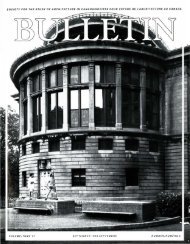CANADA - SEXTONdigital
CANADA - SEXTONdigital
CANADA - SEXTONdigital
Create successful ePaper yourself
Turn your PDF publications into a flip-book with our unique Google optimized e-Paper software.
J ULIAN SMITH > ESSAY I ESSAI<br />
the articles contributed to this issue by<br />
Jacqueline Hucker and Lane Borstad.<br />
The Vimy commission was the perfect<br />
opportunity for Allward to push the<br />
limits of these tendencies (fig. 2) .<br />
FIG . 2. A PHOTOGRAPH OF THE MONUMENT AT THE TI ME<br />
OF ITS COM PLETION, 1936. LIGHT IS USED TO GIVE<br />
THE STRU CTU RE ITS FORMAL QUALITY AS A SIN GLE<br />
COM POSITION OF SOLID AN D VO ID.<br />
possible. And in fact the reason the<br />
first option, a do nothing option, was<br />
rejected in the brief was that the decay<br />
would be so severe that eventually the<br />
monument would have to be completely<br />
rebuilt. And yet here it was, being almost<br />
completely rebuilt anyway (fig. 1).<br />
There are two reasons that shaped<br />
the final decision on how to proceed .<br />
The first was technical -the inherent<br />
causes of decay were so intrinsic<br />
to the way the monument had been<br />
constructed, that there was a requirement<br />
to redesign the fundamental<br />
structural underpinnings of the wall<br />
systems. The second, and more compelling<br />
reason, was philosophical -<br />
the integrity of the monument was<br />
threatened if the abstract purity of its<br />
form was compromised. It w as an artifact<br />
that could not readily accept the<br />
patina of gradual decay and localized<br />
repair, that was designed to challenge<br />
traditional notions of materiality and<br />
the effects of time.'<br />
DRAWINGS. THE TEXTURE OF THE INDIVID UAL<br />
MASONRY UN ITS IS SECONDARY TO THE SHAPE OF<br />
THE WHOLE. IT IS A COM POSITION THAT IN THEORY<br />
COU LD HAVE BEEN MOULDED FROM A FEW GIANT<br />
BLOCKS, SUGGESTING THE TENDENCIES OF<br />
MODERNIST ABSTRACTION. ! BORSTAD CATALOGUE# 253.<br />
Both the technical and philosophical<br />
reasons had to do with Walter Allward's<br />
embrace of emerging modernism. As<br />
the conservation field is increasingly<br />
faced with the conservation of modernist<br />
icons, it is worth reflecting on the<br />
implications of the style and the values<br />
that modernism embodies .<br />
In the case of the Vimy Memorial, the<br />
project emerged out of the cultural upheaval<br />
created by the Great War, the<br />
crucible within with the key principles<br />
of modernism were forged . There was<br />
a desperate search for a new and more<br />
universal design idiom; an idiom free of<br />
the kind of national and ethnic identities<br />
that were seen to have led to the<br />
immoralities and atrocities of the war.<br />
And Allward, designer of the Vimy<br />
monument and overseer of its construction,<br />
w as well placed to understand this<br />
angst and to help find a way out of the<br />
morass. He had already been exploring<br />
a modernist aesthetic in his sculptural<br />
work and in his drawings, as shown in<br />
The importance of Allward's work can be<br />
understood by placing the Vi my Memorial<br />
alongside other World War I memorials<br />
such as those discussed by Gavin Stamp's<br />
article in this issue. Most ofthem exhibit a<br />
more traditional design approach, firmly<br />
rooted in Victorian and Edwardian stylistic<br />
devices and conventions. The Vimy Memorial<br />
stands out in the simplicity of its<br />
conception and the unremitting rigour of<br />
its execution. Many projects, during the<br />
process of detailing the design and then<br />
implementing the construction, move<br />
from a relatively simple underlying concept<br />
to a more complex composition of<br />
colour, texture and form. Allward became<br />
obsessed with maintaining, throughout<br />
the project, the purity and the formal simplicity<br />
of his original concept. What we<br />
see at Vi my is the impulse that becomes a<br />
hallmark of modernism -the use of spareness<br />
and formal purity to get out from<br />
under the weight of historical precedent<br />
and to avoid the specificity of traditional<br />
materials, stylistic details, and methods<br />
of assembly.<br />
Most telling, at Vi my, was Allward 's treatment<br />
of surface. His conceptual drawings,<br />
not only for Vimy but for earlier<br />
explorations of memorial architecture,<br />
reveal an interest in the whole as something<br />
quite different from the sum of<br />
the parts. He always drew his designs, no<br />
matter what the scale, as simple volumes<br />
with unbroken surfaces that appear to<br />
be carved from single blocks of material.<br />
And the material itself is not important.<br />
It is simply a continuous surface that plays<br />
out the three-dimensional geometry of<br />
his design. The power of these images is<br />
in the subtlety of the forms, particularly<br />
50<br />
JSSAC I JSEAC 33 > N" 1 > 2008
















